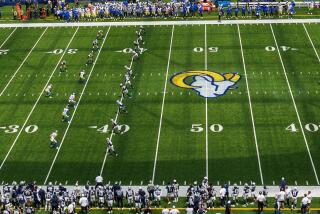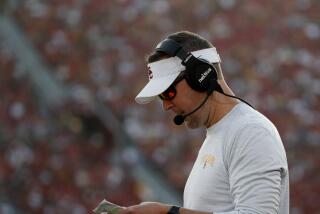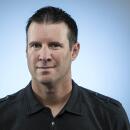NO FOOLINâ
Bob Toledo practically roars when he hears the reason for the phone call.
Trick plays. Always one of his favorite topics.
âWe have two or three a game here,â said the former UCLA coach, now in his fifth year at Tulane. âOur fans canât get enough of them.â
Toledo definitely takes it to the extreme, mixing in reverse passes and quarterback throwbacks practically as often as he sends out his punt team.
But for head coaches in the NFL, trick plays are considered dangerous, potential career-enders, monsters with long sharp teeth waiting to end a quarterbackâs season. Think Bill Belichick ever laughs when talking about trick plays?
Apparently, the âon any given Sundayâ adage doesnât apply to gimmickry in the NFL.
âCollege football is completely different than pro football,â ESPN analyst Jon Gruden said. âI donât even think youâre talking about the same sport anymore.â
Trick plays were traditionally considered necessary gambles for the underdog in a college game. Take a chance, try a halfback pass, and maybe luck will shine upon Central Hapless State.
Now theyâre standard fare for many of the top college teams, as UCLA has painfully learned this season.
Last Saturday, Stanford quarterback Andrew Luck successfully grabbed with one hand a pass from receiver Drew Terrell in a quarterback throwback that beat the Bruins for 13 yards.
Last month, Texas quarterback Case McCoy moved to his left and flipped the ball on a reverse to a receiver, who then lobbed it to a tight end for an easy score from UCLAâs five-yard line.
The pros, by comparison, are more predictable.
A fake handoff on a play-action pass is as exotic as some offenses get. Others consider a reverse a huge display of razzle-dazzle.
Why so safe?
âJob security,â said Sammy Knight, an NFL safety for 12 years and now a graduate assistant coach at USC. He has noticed that pro coaches donât have as long a leash as college coaches.
âIf a trick play doesnât work [in the NFL], that could be your job if you get the quarterback hurt and heâs out for the season,â Knight said. âThat doesnât look too good on your resume.â
Lack of time is another reason.
The Oakland Raidersâ playbook is 700 pages, most of it dedicated to standard sets, page after page of bread-and-butter stuff that has to be perfected. A mere 20 minutes spent on gadget plays would take away from the importance of nailing the basics on offense.
Then thereâs the experience factor.
Pro defenders obviously arenât freshmen and sophomores. An NFL cornerback in his eighth season is considerably less likely to be fooled than an 18-year-old whoâs barely settled into his dorm room. âPlayers in the NFL are faster, they have quicker reactions and they donât bite [on fakes] as much,â Knight said.
The pros also shy away from trick plays because of the specialization, and success, of their standard offensive sets. Itâs hard to imagine New England running back BenJarvus Green-Ellis ever throwing a football as long as Tom Brady is on the team.
College coaches, however, have reason to worry.
Every week, USC coaches try to warn the defense about goofy plays, showing players a âtrick tapeâ of gimmicks the upcoming opponent has used in recent games.
College players are limited by NCAA rules to 20 hours a week of football-related activities during the season. Not so for the pros, who donât have the competing worry of getting good grades.
âThey donât have study halls and they donât have classes and they donât have tutors,â said USC assistant head coach Monte Kiffin, who spent 26 seasons as an NFL assistant. âTheyâre out there watching tape [in the pros]. And coaches have them year-round.â
Toledo was as imaginative as they came as UCLAâs head coach from 1996 to 2002, throwing anything at an opponent, particularly during a school-record 20-game winning streak that ended in 1998.
The last time the Bruins played in the Rose Bowl game (1999), they set a record at the time with 538 yards and scored on Freddie Mitchellâs 61-yard pass to Durell Price. Thatâs a receiver throwing to a fullback.
âIt was just like playing flag football,â Mitchell would later say. It was almost too bad UCLA lost that game to Wisconsin, 38-31.
Toledo insists it doesnât take long to create on-field chaos. âIâll run a trick play once or twice a day in practice, eight times maximum in a week,â he said. âPeople think we spend all day on it. We donât.â
California Coach Jeff Tedford didnât waste any time dialing up a defense-wrecker. The first play he called as Calâs head coach was a double pass that went for a touchdown against Baylor.
Has there ever been a bigger play in a bigger upset than Ian Johnson scoring a two-point conversion on a Statue of Liberty handoff to push Boise State past Oklahoma in the 2007 Fiesta Bowl?
To Gruden, every play in college football is a tricky one, especially with all those no-huddle offenses that run the spread and line up in the shotgun formation.
Heâs still blown away by a trip to Oregon a couple of years ago to see the Ducksâ high-volume offense.
âThe ball-faking is so good you need to have four eyeballs to see whatâs going on,â Gruden said.
There are plenty of tricks in college football, but USCâs Kiffin seemed to have had enough of the notion.
âIf youâre a defensive coach,â he said, âthey shouldnât work.â
twitter.com/Mike_Bresnahan
More to Read
Go beyond the scoreboard
Get the latest on L.A.'s teams in the daily Sports Report newsletter.
You may occasionally receive promotional content from the Los Angeles Times.











